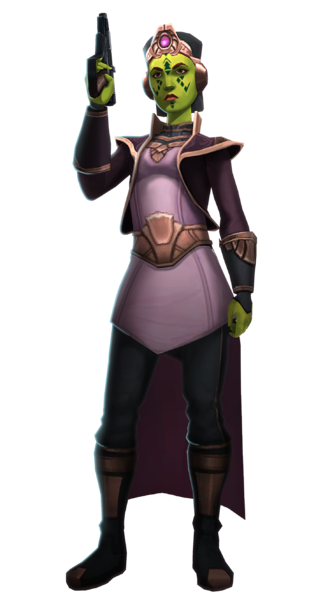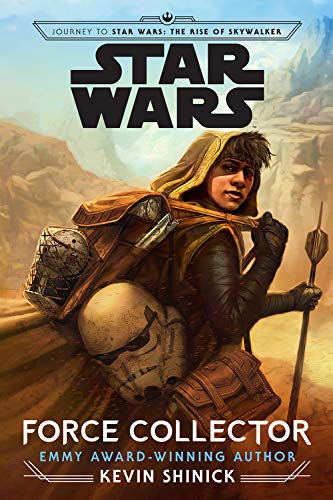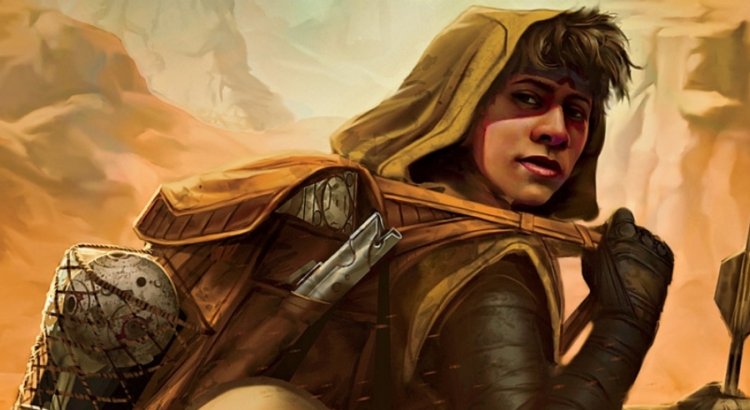This review is almost completely spoiler-free, I mention some minor details about who the main characters are but don’t get into the plot events.
I’d been curious about Force Collector ever since it was announced. They told us that it was a middle-grade novel about a kid gathering artifacts to learn more about the Force and the Jedi specifically. Generally, Jedi stories aren’t my favorite: but stories about artifacts and the general mythical environment around Jedi and the Force? I love those. The teaser info we got from author Kevin Shinick at New York Comic-Con sealed the deal: he told us it was a story about someone trying to uncover the events of the Star Wars films who had never heard of or seen anything to do with those events. The main character, Karr, gets strange visions when he touches artifacts that have “experienced” a lot of history or momentous events (historians would envy him that ability!) and begins to uncover bits and pieces of Star Wars history through experiencing vignettes from the books, comics, and movies.
Force Collector isn’t a “clip show” kind of story, and thank goodness for that. It reminds me of the initial pitch for Lost Stars, where Claudia Gray said she was initially told to write a story that introduced the YA audience to the original Star Wars films in a new way – and she created such a compelling story with her original characters that she went well beyond that original idea and created something special. The visions we see in Force Collector are interstitial visions, showing scenes before and after key Star Wars events to show them in a different context, but it’s the framing story that’s the real star for me. I liked Karr as a character, as well as his droid RZ-7 and his friend Maize. Karr’s whole deal is what got me interested in the book in the first place, and the two kids trying to figure out who they are and what they want in life is what kept me reading. It’s a story about regular people in Star Wars, and I love that stuff.
That’s not to say that the visions and Force stuff aren’t interesting. They are, but maybe for a different reason. When Del Rey’s Resistance Reborn recently released, there was some discussion about whether the book was approachable for new readers of the Star Wars literary universe. Some people made some excellent explainers about what people needed to know before reading it (you can take Star Wars Explained as the premiere example of that) while others got lists of lore and facts from the book to add to other lists of lore and facts. And it got me thinking about how different readers grow and become familiar with the universe differently. Some people enjoy reference books with charts and diagrams, some people really appreciate explainer videos, and others better digest “facts” and lore through the form of a narrative story. That’s basically what the premise of Force Collector is: it’s a book accessible to readers completely new to Star Wars books, that presents them with information about the Star Wars galaxy in a narrative fashion. And I think maybe that’s why a successful framing story is so important for this: Karr and Maize are just as new to a lot of this Force and Jedi stuff as a brand new movies-only reader might be, and being able to identify with them as characters helps readers explore Star Wars lore all the easier.
Likable characters
One big reason for my enjoyment of this book is that I really enjoy the characters in the framing story. Karr is an interesting character because he has a gift that also looks like a health condition (his visions lead to him blacking out) and his family makes him doubt what he sees, except for his grandmother. His relationship with his grandmother is one of the most interesting parts of the story, as is Karr trying to figure out who he is and who he wants to be. He has spent his life wondering if something was wrong with him — and why he didn’t belong. His family wants different things for him, but those aren’t necessarily his dreams. It’s a story that might be relatable to young people reading it – their families pressuring them to do one thing or another, while they just want to be themselves (but are in turn unsure what they want). It’s not unique or original, but it’s framed in a way that I think young Star Wars fans (and older ones!) can relate to.

The other main character in the book, Maize, is probably my favorite. She’s a mixed-race Mirialan with mixed views on her heritage (particularly her mom’s traditionalism) and frustrated relationships with her very busy father. She’s another character archetype that seems familiar, but I think it works – particularly in the context of her background. Usually I’m not a huge fan of substituting aliens for minorities in Star Wars because there’s little enough minority representation in Star Wars to begin with, but I think Maize being half-Mirialan really works in the context of this story. There’s no sense that Star Wars humans of different backgrounds experience the same issues as they might in real life – but mixed alien heritage can be a way to explore that. Refreshingly, Maize’s issues are personal and with her own relationship with her family and her background. It’s not really about prejudice, and it’s nice to see a story where being of a different background is just accepted. We also get to explore issues of social class among schoolchildren on this frontier planet since Maize is from a more privileged background than Karr. I thought it was interesting to show that her background may be atypical, but that didn’t mean she also didn’t have things going for her. My only regret with Maize is that because the story is tightly third-person from Karr’s perspective, we never really get to see things from her point of view. It makes sense for the type of story being told, but she’s such a good character I can’t help but regret that. I’m reminded in many ways of the excellent Merei Spanjaf from Jason Fry’s Servants of the Empire series – like Maize, Merei was a companion character for protagonist Zare Leonis in the first and second books, but she got to graduate to a full point-of-view character by the third book of that series. It would’ve been nice if Maize started out as a viewpoint character.
Before I leave the point of aliens entirely, I have to add that this story is refreshingly diverse from the species perspective. Karr is a kid in school on a middle-of-nowhere planet, but his classmates and teachers are aliens of all types and there is no sense at all that this is particularly unusual. It’s a little thing, but it’s nice to see that bit of diversity. Human diversity is still my primary interest, because humans are real and deserve to be seen in stories, but I do still like to see species diversity in Star Wars. It just makes sense.
Since I promised to stay mostly spoiler-free, I’m going to stop here with the framing story. I found Karr and Maize to be very interesting characters, and I enjoyed the adventure that unfolds for them. Sometimes I almost felt as if the Force stuff was a distraction to that story, but I think it might have a different impact on readers fresh to Star Wars or readers really into the Force stuff. For some readers, learning about the Force is the primary draw of the story – and I think they’ll be happy about that! And like I said – sometimes I find the mysticism and mythology quite interesting, and the story absolutely does touch on that stuff. The Force and the story of the Jedi is certainly very important to Karr and he’s bent to uncover the truth behind the mythology if he can.
Learning about the galaxy
Karr and Maize make for excellent framing protagonists for the visions and Force stuff in the story because they both know so absolutely little about the Force. We’re in the sequel era and the Jedi are basically a myth, as we know from The Force Awakens or Legends of Luke Skywalker. But the galaxy still very much feels their presence, because they were around not all that long ago. The questions are: did they really exist, and did they really have powers?
Who knows! We do, but that’s not the point. Through their story of discovery, the characters travel to various locations from the Star Wars saga and published stories and learn about these places as they do so. This isn’t a reference book, but you naturally pick up a few things here and there as they travel. And that got me to thinking.

Way back when I was a kid, I first learned Star Wars lore through stories. I read the old Expanded Universe novels, and they’d reference planets, characters, and places in the context of their story (I first learned of Thrawn through the Kevin J. Anderson books, and though I took a little while to get to the Thrawn books, I felt like I knew enough about him from those references). There were also guide books, things like the Essential Guides that were filled with facts, drawings, and figures. I loved those books as a kid too – but somehow the lore I picked up through stories, through experiencing a character’s journey, always stuck with me more. Even today, I love reference books but the ones that are pure facts-and-figures don’t really work for me – I prefer the ones that are “in-universe” documents, telling stories even while they’re giving us information.
My preferences are just mine of course, and plenty of people love solid charts, facts, and cutaway drawings of spaceships. For those who don’t, a book like Force Collector seems to be a very approachable way to visit worlds and planets that are just dropped off-hand in other books as if the reader should just know them already.
It’s rare that a Star Wars book actually demands that you understand every reference and easter egg to enjoy the story. In fact, it’s rarer still that a book which does demand the understanding of arcane references could possibly be a good book (but there are always exceptions for things done right!). I can’t think offhand of a recent Star Wars novel that really required understanding these references, though occasionally some stories are better appreciated having read other stories prior to them.
But even still: I get the idea that unfamiliarity feels unwelcoming or intimidating. When I read books from franchises that I don’t understand (like if I just picked up some Lord of the Rings book), the unfamiliar terminology scares me and sometimes makes me feel like I don’t understand what’s going on. This happens even though I know I should be paying attention to the characters and what’s happening in the story – it’s natural.
Force Collector is the kind of book that helps smooth that over. It’s a story you read to experience an enjoyable adventure about kids exploring the history and lore of Star Wars, and it helps you learn stuff along with that experience. And I think the framing story is good enough that even if you aren’t interested in lore (or if you already feel comfortable with it), you might enjoy a fun read with personable characters.

